Total Solar Eclipse Live Stream: Watch The Spring Equinox Event Here; How To View Safely

A total solar eclipse is the best way to ring in the first day of spring. The spring equinox is Friday and Europe, North Africa and North Asia will witness a partial eclipse. But heading farther north to the Faroe Islands or Svalbard will reward the intrepid with a front-row seat to a total solar eclipse, in which the moon totally blocks the sun. (Eclipse hunters may have to worry about polar bears in Svalbard.) The robotic telescope service Slooh will host a total solar eclipse live stream from the Faroes starting at 4:30 a.m. EDT. The event is worth waking up early for since the next total eclipse in the U.S. won't happen until 2017.
Astronomers and stargazers on Earth will not be the only ones tracking the eclipse. The European Space Agency will have several mini-satellites tracking the event. The Proba-2 mini-satellite will view the total solar eclipse twice, while another Proba mini-satellite will track the shadow of the moon on Earth. Despite it being a partial solar eclipse, most of Europe will be plunged into shadow. Around 84 percent of the sun will be blocked out over England, 75 percent over Paris and 65 percent over Milan, ESA reported. Residents of the U.K. should make the eclipse a priority as the next partial solar eclipse there will not take place until 2026 and the next total solar eclipse will not happen until 2090.
"Nothing -- and I mean absolutely nothing in nature -- is as powerful and spectacular as the totality of a solar eclipse. Sadly, they only happen every 360 years on average for any given location, which means that a very low percentage of the population has ever seen one," Slooh astronomer Bob Berman said. "This time, the moon's shadow sweeps over the remote Faroe Islands of the North Atlantic. Slooh has sent a team equipped with specialized, proprietary equipment to bring this spectacle live to the rest of our planet. This event should not be missed."
If you plan to view the solar eclipse, do not look directly at the sun. There are several ways of safely viewing a solar eclipse. NASA recommends #14 welder's glasses or film glasses with aluminized screens. The space agency does not recommend using X-ray film, smoked glass or sunglasses as filters. There are telescopes designed for solar observations that can be used for the event. Another easy way to view the solar eclipse is by building a pinhole projector or looking for the sun's shadow on the ground.
There are multiple live streams to choose from, including views originating from the U.K. and Israel. The Telegraph has a solar eclipse stream that begins at 2 a.m. EDT and can be viewed below.
Slooh's total solar eclipse live stream from the Faroe Islands begins at 4:30 a.m. and can be viewed below.
http://phys.org/news/2015-03-supermoon-mischief-sun-sea.html
http://phys.org/news/2015-03-solar-eclipse-norway-mind.html
http://phys.org/news/2015-03-europe-braces-unprecedented-power-issues.html
© Copyright IBTimes 2025. All rights reserved.





















